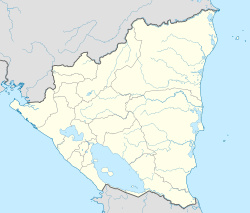Ciudad Darío facts for kids
Quick facts for kids
Ciudad Darío
|
|||
|---|---|---|---|
|
Municipality
|
|||
|
|||
| Country | Nicaragua | ||
| Department | Matagalpa Department | ||
| Area | |||
| • Municipality | 735 km2 (284 sq mi) | ||
| Elevation | 433 m (1,421 ft) | ||
| Population
(2022 estimate)
|
|||
| • Municipality | 54,063 | ||
| • Density | 73.56/km2 (190.51/sq mi) | ||
| • Urban | 23,327 | ||
| Time zone | UTC-6 (Central (CST)) | ||
| Climate | Aw | ||
Ciudad Darío is a town and a municipality in the Matagalpa Department of Nicaragua. It is famous for being the birthplace of two important people: Rubén Darío, a very famous poet, and Edén Pastora, a well-known leader.
This town was once known by other names, like Metapa and Chocoyos. Ciudad Darío is located about 90 kilometers (or 56 miles) away from Managua, the capital city of Nicaragua.
History of Ciudad Darío
Early Times
Long, long ago, this area might have been part of a large ancient lake. A river called the Ucumulali River flowed from it towards the Pacific Ocean. Over many years, big movements of the Earth changed the land. These changes created mountains and made the river flow in a different direction than before.
The first people to live here were the Matagalpa Indians. Their main village was near a lagoon called Moyua. Scientists who study old things have found stone columns there. These columns might have been part of an ancient temple.
Colonial Period
In 1528, Spanish explorers found some small Indian villages in this area. The acting governor, Diego de Castañeda, told Captain Gabriel de Rojas to find a way from here to the sea in the north. He traveled with many people, both on foot and on horses.
Later, in 1627, a priest named Fray Garcia de Loaysa encouraged several Matagalpa Indians to settle in this region, which was then called Metapa. The town was first known as Chocoyos. This name came from a small green parrot that was common there. It also came from the local custom of building homes from green tree branches.
During the time Spain ruled Nicaragua, the town was an important stop. It was on the way to the mountain towns of Matagalpa and Nueva Segovia. Missionaries and soldiers often rested there as they traveled into the country. In 1685, a bishop named Fray Ramon Rojas died in Metapa (Chocoyos). He was very tired after escaping from a pirate attack. In 1703, another missionary, Fray Antonio Margil de Jesus, visited Chocoyos. Then, in 1752, Bishop Fray Agustin Morel de Santa Cruz visited. It was at this time that the town's name was changed to Metapa.
After Independence
In 1856, Metapa became a base for a group called the “Junta de Recursos.” This group was made up of Nicaraguan patriots. They collected money to create an army called the "Ejército del Septentrión" (Northern Army). This army fought against the "Filibustero" troops of an American adventurer named William Walker. Walker had declared himself the President of Nicaragua.
In 1857, Metapa became part of the new Matagalpa Department. This change was made by the government of General Tomás Martínez.
On January 18, 1867, a very important person was born in Metapa: Felix Rubén García. He later became known as Rubén Darío. He is considered one of the greatest poets in the Spanish language.
On February 20, 1920, Metapa changed its name to Ciudad Darío. This was done by a special order from the government of President Emiliano Chamorro. The new name honored the famous poet.
In 1943, the house where Rubén Darío was born was made into a national museum. It is located near the center of the city. The building still looks much like it did originally, even after being fixed up since 1999. Every year on January 18, which is Darío's birthday, people gather at the house. They have poetry readings, dance performances, and other fun cultural activities.
See also
 In Spanish: Ciudad Darío para niños
In Spanish: Ciudad Darío para niños




